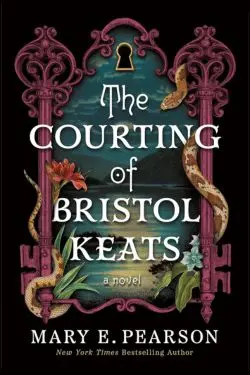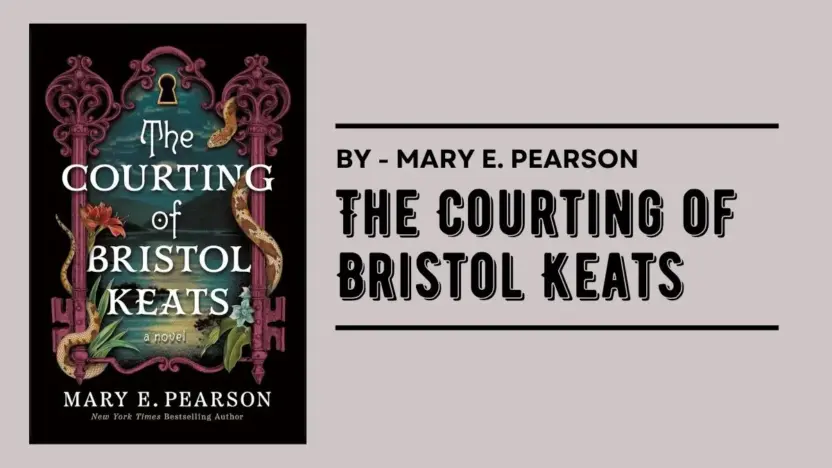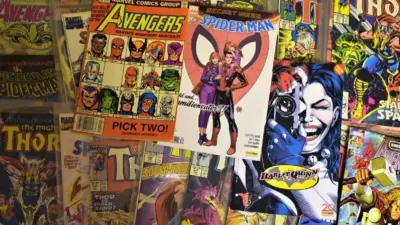Mary E. Pearson’s “The Courting of Bristol Keats” marks her debut into adult fantasy, weaving a tale rich with fae lore, family secrets, and a journey of self-discovery. This novel introduces readers to a world where the mundane intertwines with the magical, offering a narrative that is both enchanting and emotionally resonant.
Plot Overview
The story centers on Bristol Keats, a young woman grappling with the recent loss of her parents. Residing in the quiet town of Bowskeep with her sisters, Bristol’s life takes an unexpected turn when she receives letters from an unknown “aunt.” These letters suggest that her father, presumed dead, might still be alive, having been taken to a realm inhabited by gods, fae, and monsters. Determined to uncover the truth and rescue her father, Bristol embarks on a perilous journey into this mystical world. There, she encounters Tyghan, a formidable fae leader with his own hidden motives. Their alliance is fraught with tension, secrets, and the potential for betrayal.

Character Development
Pearson crafts her characters with depth and nuance. Bristol emerges as a resilient protagonist, her determination and courage driving the narrative forward. Her evolution from a grieving daughter to a formidable force in a magical realm is both believable and compelling. Tyghan, the enigmatic fae leader, is portrayed with layers of complexity. His interactions with Bristol oscillate between antagonism and reluctant partnership, adding a dynamic tension to their relationship. The supporting cast, including Bristol’s sisters and various inhabitants of the fae realm, enrich the story, each contributing to the unfolding drama.
World-Building and Setting
One of the novel’s standout features is its immersive world-building. Pearson introduces readers to Elphame, a realm teeming with magic, political intrigue, and diverse creatures. The fae society is depicted with intricate details, from its hierarchical structures to its cultural norms. The author’s descriptive prose brings this world to life, allowing readers to visualize the lush landscapes, grand palaces, and perilous terrains that Bristol navigates. This meticulous attention to setting enhances the narrative’s depth and authenticity.
Themes and Motifs
At its core, “The Courting of Bristol Keats” explores themes of identity, family, and the quest for truth. Bristol’s journey is not just a physical one but also an exploration of her heritage and the secrets that have shaped her life. The novel delves into the complexities of familial bonds, the sacrifices made for loved ones, and the lengths one will go to uncover hidden truths. The interplay between the mortal and fae worlds serves as a backdrop to these themes, highlighting the contrasts and connections between different realms and cultures.
Romantic Elements
The relationship between Bristol and Tyghan introduces a slow-burn romance that adds depth to the narrative. Their interactions are marked by tension, mutual suspicion, and an underlying attraction. Pearson avoids clichéd romantic tropes, instead allowing their relationship to develop organically amidst the unfolding plot. This approach adds a layer of realism to their connection, making their evolving bond both engaging and believable.
Critical Reception
The novel has garnered positive reviews from both critics and readers. Vilma Iris describes it as “an enchanting blend of romantic fantasy, fae lore, and family drama—an exciting and promising series starter.” Similarly, a review from Books & Vinyl praises the book’s “amazing characters caught in dramatic and secret-laced situations, with politics of the world pulling them in every direction.” These reviews highlight Pearson’s ability to craft a compelling narrative that resonates with fans of the fantasy genre.
Narrative Pacing and Structure
Pearson’s storytelling is characterized by a balanced pacing that maintains reader engagement throughout. The narrative seamlessly transitions between moments of high tension and introspective reflection, allowing for character development alongside plot progression. The structure of the novel, with its interweaving subplots and multiple perspectives, adds complexity without causing confusion. This approach ensures that readers are continually invested in the unfolding story.
Writing Style
Pearson’s prose is both lyrical and accessible. Her descriptive language paints vivid images of the fae realm, immersing readers in its beauty and dangers. Dialogue is crafted to reflect character personalities and relationships, adding authenticity to their interactions. The author’s ability to convey emotion through her writing enhances the reader’s connection to the characters and their journeys.
Comparative Analysis
Fans of authors like Sarah J. Maas and Holly Black will find “The Courting of Bristol Keats” appealing. Pearson’s exploration of fae mythology, combined with a strong female protagonist and intricate world-building, aligns with the works of these authors. However, Pearson brings her unique voice to the genre, offering fresh perspectives and original plotlines that set her work apart.
Conclusion
“The Courting of Bristol Keats” is a captivating addition to the fantasy genre, showcasing Mary E. Pearson‘s talent for storytelling. With its rich world-building, complex characters, and exploration of profound themes, the novel offers readers an immersive experience. As the first installment in a duology, it sets the stage for further adventures in a world where magic and reality intertwine. Readers will undoubtedly look forward to the continuation of Bristol’s journey and the unfolding mysteries of the fae realm.
Also Read: Skyshade: By Alex Aster (Book Review)



